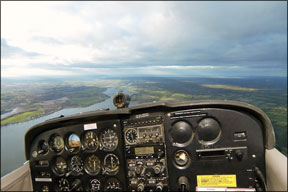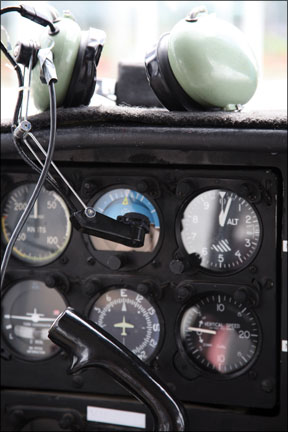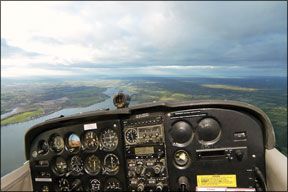Congratulations! Youve just passed your instrument practical test. A significant achievement, requiring much more discipline and learning than even the private pilot exam. Or maybe youve held your instrument rating for a while, but youve never developed a plan to improve your skills. You may have even let your skills erode in some areas, to the extent you couldnt pass every task if you had to retake the 288 practical test today. Why You Need A Plan Unfortunately, most pilots get handed the proverbial “license to learn” by a pilot examiner, then dont really know what to do next except “go out and fly.” To avoid aimlessness or atrophy of your instrument skills and the life-threatening danger aimlessness breeds, first ask yourself what type of flying-personal transportation, time-sensitive business flying, etc.-you plan to do. Commit to a goal, whether its simply maintaining your skills at basic IFR levels, advancing beyond your current capabilities, or aiming for airline transport pilot standards. Then map out a program for the next 100 flight hours to develop and hone the necessary skills. Emphasis should be on safety, aimed toward what you want to do with airplanes. Be serious, but keep it interesting, challenging and fun. Getting Actual I remember one instrument student who, when we climbed into the overcast the first time, started involuntarily shaking his right knee and rhythmically pushing on the right rudder pedal. Jab, jab, jab went the rudder; yaw, yaw, yaw went the airplane. “Calm down, Jeff,” I coached, trying to limit rudder movement with my feet to render his jabs less effective. Eventually we climbed through and between layers, and the nervous twitching stopped. But on this fairly experienced instrument students first foray into IMC he exhibited symptoms of unease that Im certain could have built into a loss of control had no one been there to stop them. One of the true tragedies of instrument training is that its possible, even likely, youll earn your instrument rating without ever actually going into the clouds. Like it or not (and I dont), thems the rules-its the rare newly minted IFR pilot who has spent any time in “actual” weather. That means once youve passed the checkride its your responsibility to develop safety, comfort and confidence in true flight by reference to instruments. You dont want to find out you have some distracting response to losing outside reference when youre alone in the airplane, or with family or passengers aboard who dont have the skills to help you through it. Legal, But Not Safe Pass one checkride and youre set for life under the FAAs regulations. Youll recall FAR 61.57c states: No person may act as pilot in command under IFR or in weather conditions less than the minimums prescribed for VFR, unless within the preceding six calendar months, that person has…performed and logged under actual or simulated instrument conditions, either in flight in the appropriate category of aircraft for the instrument privileges sought, or in a flight simulator or flight training device that is representative of the aircraft category for the instrument privileges sought: At least six instrument approaches; Holding procedures; and Intercepting and tracking courses through the use of navigation systems. Squeak through your instrument Practical Test, log six approaches (all the same one, if you want) and one holding pattern every six months, either of which requires intercepting and tracking navigation systems, and you never have to spend time with an instrument instructor or an examiner again. But what will you have learned? Would you want to ride in the back of an airplane flown by a pilot barely meeting this standard, if you know youll be bouncing through a turbulent non-precision circling approach on a dark and stormy night? Clearly the FAA expects us to develop a personal training regimen far exceeding FAR 61.57c minimums. Elements of a Plan Whatever your personal goals for the next 100 flight hours, they should include specific actions toward: Retention of those skills you learned and demonstrated for your checkride; Customization of your flying repertoire to the sort of flying you plan to do; Enhancement to the next level of skill and proficiency; and Along the way, youll also need to exercise some quality control to ensure your skills are safe and effective, and to detect and correct any bad habits you may have picked up along the way. Retention of flying skills is critical to safety, but often receives little attention after 288 passing a checkride. As weve said, the FARs, in fact, allow instrument pilots to fly an entire lifetime without ever receiving any additional instrument instruction or evaluation, as long as they log a laughably small amount of experience every six months. The instrument skills you learn must be instinctive, however, to serve you when faced with unusual situations, hazardous weather or distractions. Include occasional instrument instruction, practice instrument maneuvers with a safety pilot or experienced instrument mentor, and use all available types of navigation (not just GPS). Hand-fly, use a flight director and fly by autopilot as airplane equipment permits. Include simulated emergencies to retain basic skills as you add to your overall experience. Some pilots will stick with “light IFR,” flying only when ceilings and visibility permits visual takeoffs and landings. Others want cross-country utility for personal and business trips, flying in challenging weather conditions to meet a busy schedule. Yet more are aiming toward a professional flying career. As you put together your plan for the first 100 hours of your instrument privileges, customize your program to include skills that will make you better at the type of flying you plan to do. Itll be fun because it helps you achieve your ultimate goal. In addition to better preparing for the specific type of flying you desire, include skills-enhancement in your 100-hour plan. Enhancement might involve spending time with a mentor pilot-the local charter pilot, or maybe a retired airline captain-learning from his or her years of experience. Enhancement includes developing judgment and go/no-go decision-making skills; experience with advanced cockpit technologies; controlled excursions near extreme weather in a properly equipped airplane with an appropriately expert pilot; work toward the ATP certificate; and anything else that will make you a more “well-rounded” pilot. Your 100-Hour Plan With your goals in mind, map out a plan for the first 100 hours of instrument experience. Summarized on the opposite page, for example, is a rather ambitious strategy to complete 100 hours of IFR experience and training in one years time. Flying is divided between retention, customization, enhancement and quality control. Your personal plan may look significantly different, but should contain the same basic elements. You may not be able to complete 100 hours in a single 12-month period. Weather, finances or life itself may get in the way. If you fly less frequently, plan to spend even more time in practice and quality control before you reach your goals. With the help of instructors, mentor pilots and your own good judgment, develop your own path from rating to expertise, making regular practice and quality control a part of your lifelong aviation learning. Obviously youll be flying additional time on regular trips that dont fit the requirements of your plan. Dont forget to include practice of flyings basics-stalls, takeoffs and landings, etc.-along with your instrument 100-hour plan. Further, all times are approximate. This plan is a guide, not a dictate. Not all blocks must or will be flown in a single flight. Four hours of quality control, for instance, may be broken into two or three flights. The sequence of events is not linear. You dont have to wait to fly dual in LIFR, for instance, before you complete solo Instrument Approach Procedure (IAP) practice. Night practice doesnt have to wait until nine months into your post-checkride experience. Take things in a logical order, but consider each item a unique task to be performed before considering your first 100 instrument hours to be complete. An exception is quality control. Stick to the calendar schedule. Its very important to get back in the cockpit with a CFII on a fairly routine basis, especially when new to the world of IFR. As you gain experience, more and more of your flying will be “retention” and “customization,” because there will be less “enhancement” of your skills. Never think you know it all, however. Even when your 100 hours is done, youre not done learning. Fly with different mentor pilots or instructors, and include a thorough annual IPC in your continuing aeronautical education. If youre instrument-rated, you should be committed to training for life. Putting It All Together Just like completing your instrument rating, moving forward works best if you map out a strategy to meet your goals. The fun part is that, unlike training to this point, you get to decide what you want to do, when you want to do it. Intersperse recurrent training and new experiences with your regular flying and youll keep it exciting and fresh-and be much more likely to keep flying, and fly more often. Further, youll gain confidence and capability while becoming safer and safer doing the type of instrument flying you want to do. And you thought it was going to get easier when you took off the Foggles!





